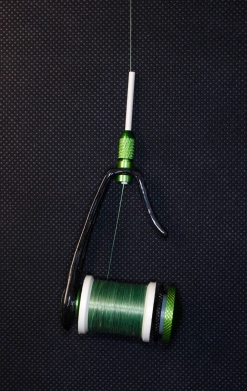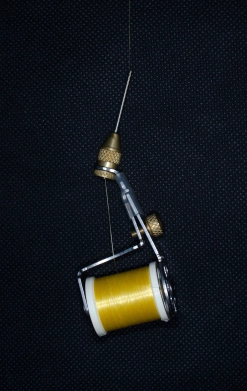If you want to use the advantages of controlling twist in your tying thread, you need a bobbin holder that allows rotation. Not all do.
I have tied with a large number of different bobbin holders, but tend to return to the same, simple model almost every time I try something new.
Twist and shout... eh, control
One of the main reasons for this is that I basically always twist and untwist my tying thread while tying in order to control the thread. Controlling thread twist while tying has many advantages, as it’s been covered many times in articles and videos on this site.
The short story is that twisted thread will tend to curl, it will fall towards or away from the hook when you form a loop while untwisted thread will be neutral and slack, and be able to lie very flat as an added bonus.
It’s not like untwisted thread is better than twisted, but knowing whether the thread is twisted or not, and which way it is, can be a great advantage when tying.
Thread control in other words.
Asymmetry
But in order to either add or remove twist, you need to be able to spin your bobbin holder. This is simply done by grabbing the tube and setting it in a vertically rotating motion – clockwise or counterclockwise when seen from above. Having used, as I said, a large number of different bobbin holders and many different designs, I have come to realize that not all of them can be rotated with equal success.
The simple, symmetrical wishbone models spin nicely. These come from a large number of manufacturers such as Griffin, Renzetti, Dr.Slick, Matarelli, Semperfli, Wasatch and many more. There are also the more complex, but still symmetrical ones like the SMHAEN, Loon and C&F bobbin holders. All these are all in balance, and spin well, smoothly and long, making it very easy to add or remove thread twist.
The slightly asymmetrical, “one legged” designs like those from Rite Bobbins and Stonfo will spin, but wobble as they do. It’s not impossible, but just a little annoying because they aren’t in balance, but heavier in the adjustment side than in the “passive” side. The result is that you can’t spin them at full speed, but have to take a little care when starting the rotation.
A bit worse are the really asymmetrical, like the retracting bobbin holders made by Faruk Ekich or the so called Apex Predator bobbin holder made by Ilias Fn Karanzas. These are almost impossible to get to spin without feeling that you are stressing the thread or your fly.
And of course, the most asymmetrical bobbin holder of them all, the J Bobbin, is basically impossible to get to spin since the tube isn’t near vertical while you are tying. Grabbing it is difficult and and spinning it will lead to very violent and erratic movements in the bobbin holder due to its very unbalanced design.
So, if you want to use thread control in your tying (And you most likely do! Trust me on that), you may take the shape and design of your bobbin holder into consideration, making your life as a “thread controller” much easier by selecting a model that spins smoothly.
Learn more about thread control in the articles and videos below.
Hand picked for this article
- Log in to post comments
















